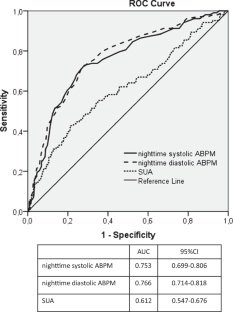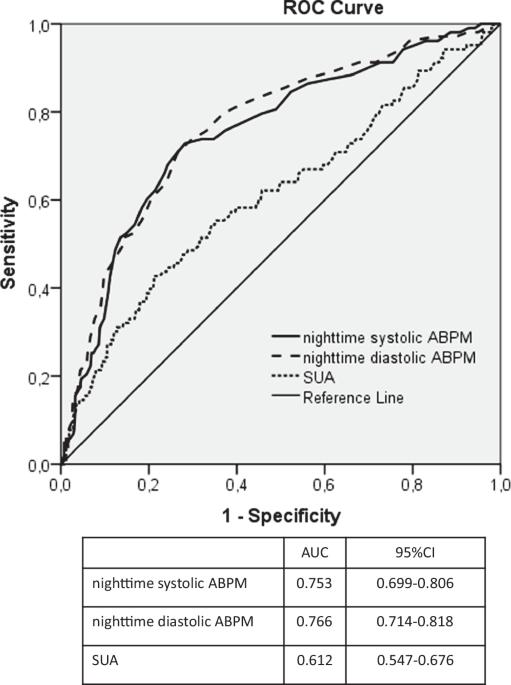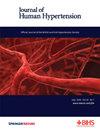Relationship between serum uric acid, nocturnal hypertension and risk for preeclampsia in high-risk pregnancies
IF 2.7
4区 医学
Q2 PERIPHERAL VASCULAR DISEASE
引用次数: 0
Abstract
To analyze the possible association between serum uric acid (SUA) and nocturnal hypertension and to evaluate the ability of these variables (alone or in combination) to predict preeclampsia (PE) we conducted a historical cohort study in 532 high-risk pregnancies. Women were divided according to SUA values and nocturnal blood pressure (BP) into four groups: 1- normal SUA and nocturnal normotension; 2- high SUA and nocturnal normotension; 3- normal SUA and nocturnal hypertension and 4- high SUA and nocturnal hypertension. High SUA was defined by the top quartile values and nocturnal hypertension as BP ≥ 120/70 mmHg, using ambulatory blood pressure monitoring (ABPM), during nocturnal rest. Risks for PE were compared using logistic regression. SUA had a weak but significant correlation with daytime systolic ABPM (r = 0.11, p = 0.014), daytime diastolic ABPM (r = 0.13, p = 0.004), nighttime systolic ABPM (r = 0.16, p < 0.001) and nighttime diastolic ABPM (r = 0.18, p < 0.001). Also, all ABPM values were higher in women with high SUA. The absolute risk of PE increased through groups: 6.5%, 13.1%, 31.2%, and 47.9% for groups 1, 2, 3, and 4, respectively, p < 0.001. Compared with Group 1, Group 3 (OR 6.29 95%CI 3.41–11.60), but not Group 2 (OR 2.15 95%CI 0.88–5.24), had statistically significant higher risk for PE. Group 4 (women with both, high SUA and nocturnal hypertension) had the highest risk (OR 13.11 95%CI 6.69–25.70). Risks remained statistically significant after the adjustment for relevant variables. In conclusion, the combination of SUA > 4 mg/dL and nocturnal BP > 120/70 mmHg implies a very high risk to developed PE.


血清尿酸、夜间高血压与高危妊娠子痫前期风险之间的关系。
为了分析血清尿酸(SUA)和夜间高血压之间可能存在的关联,并评估这些变量(单独或组合)预测子痫前期(PE)的能力,我们对 532 名高危孕妇进行了历史队列研究。根据 SUA 值和夜间血压(BP)将妇女分为四组:1- SUA 正常和夜间血压正常;2- SUA 偏高和夜间血压正常;3- SUA 正常和夜间高血压;4- SUA 偏高和夜间高血压。高 SUA 的定义是前四分位值,夜间高血压是指夜间休息时使用动态血压监测(ABPM)测得的血压≥ 120/70 mmHg。采用逻辑回归法比较了发生 PE 的风险。SUA与日间收缩压ABPM(r = 0.11,p = 0.014)、日间舒张压ABPM(r = 0.13,p = 0.004)、夜间收缩压ABPM(r = 0.16,p 4 mg/dL)有微弱但显著的相关性,夜间血压> 120/70 mmHg意味着发生PE的风险非常高。
本文章由计算机程序翻译,如有差异,请以英文原文为准。
求助全文
约1分钟内获得全文
求助全文
来源期刊

Journal of Human Hypertension
医学-外周血管病
CiteScore
5.20
自引率
3.70%
发文量
126
审稿时长
6-12 weeks
期刊介绍:
Journal of Human Hypertension is published monthly and is of interest to health care professionals who deal with hypertension (specialists, internists, primary care physicians) and public health workers. We believe that our patients benefit from robust scientific data that are based on well conducted clinical trials. We also believe that basic sciences are the foundations on which we build our knowledge of clinical conditions and their management. Towards this end, although we are primarily a clinical based journal, we also welcome suitable basic sciences studies that promote our understanding of human hypertension.
The journal aims to perform the dual role of increasing knowledge in the field of high blood pressure as well as improving the standard of care of patients. The editors will consider for publication all suitable papers dealing directly or indirectly with clinical aspects of hypertension, including but not limited to epidemiology, pathophysiology, therapeutics and basic sciences involving human subjects or tissues. We also consider papers from all specialties such as ophthalmology, cardiology, nephrology, obstetrics and stroke medicine that deal with the various aspects of hypertension and its complications.
 求助内容:
求助内容: 应助结果提醒方式:
应助结果提醒方式:


